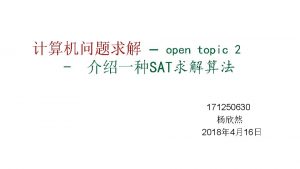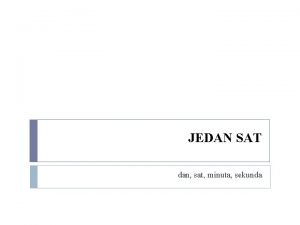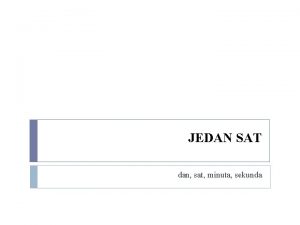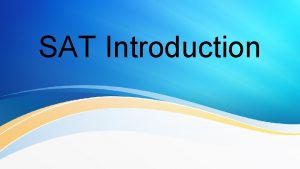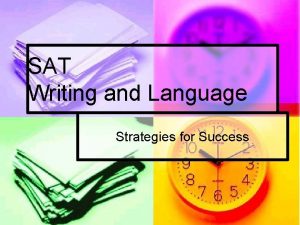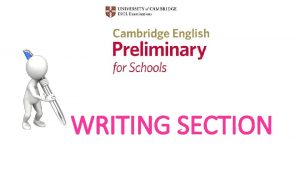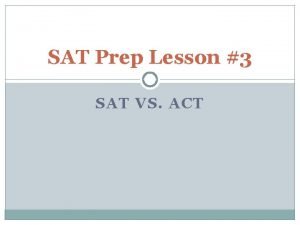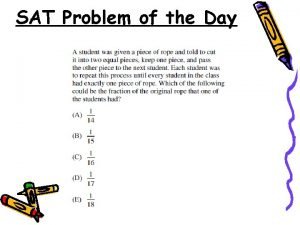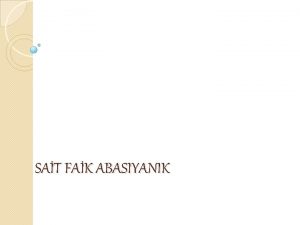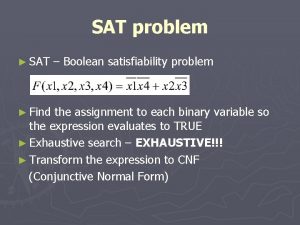The SAT Writing Section The SAT writing section


















- Slides: 18

The SAT® Writing Section The SAT writing section, which includes both multiple-choice questions and an essay, measures a student’s ability to develop and express ideas clearly and effectively. Research shows that of all sections of the SAT, the writing section is the best predictor of students’ academic performance in college. This is true for students across all racial/ethnic minority groups. This information is from: www. collegeboard. com/scorewrite

There are three types of multiple-choice writing questions: improving sentences, identifying sentence errors and improving paragraphs. n They assess a student’s ability to: use language that is consistent in tense to understand parallelism and subject-verb agreement ¨ to understand how to express ideas logically ¨ to avoid ambiguous and vague pronouns, excessive wordiness and sentence fragments. ¨ ¨ n n n Students are not asked to define or use grammatical terms Spelling and capitalization are not tested. Multiple-choice questions count toward about two-thirds of the total writing score.

n n The essay assesses students’ ability to think critically and to write effectively under time constraints similar to those they will encounter on essay examinations in college courses. Students are given 25 minutes to handwrite their essays. The essay portion of the SAT writing section was created with an understanding that an essay written in a short amount of time will not be polished but represents the initial phase of the writing process: the first draft. The essay counts toward roughly one-third of the total writing score.

n The combination of the multiplechoice items and the essay provides an assessment of writing that takes into account both the student’s ability to develop ideas in a thoughtful, coherent and cogent essay and his or her understanding of the conventions of language.

For the SAT essay, as well as for Score. Write, students will have 25 minutes to write a first draft of an original essay. This task provides a direct measure of a student’s ability, under timed conditions, to write clearly and effectively — a skill required in many college courses. Effective writing is marked by: n n the development of a point of view logical presentation of ideas clear lines of reasoning sustained focus n n n appropriate choices of evidence skillful coherence; effective organization; precise use of language engagement with the reader.

Essay Prompt n n n Students are asked to write in response to an essay assignment, or prompt, that is carefully selected so they can respond quickly in a variety of ways. Prompts are easily accessible to the general test-taking population, including those for whom English is a second language. Prompts are free of figurative, technical or specific literary references; they do not draw on specialized knowledge. The prompt stimulates critical thinking and is relevant to any number of fields and interests. It gives students the opportunity to draw on a broad range of experiences, learning and ideas to support their points of view on the issue in question.

The Prompt Format n n The prompt consists of a short paragraph (no more than 80 words) adapted from some authentic text. Following the prompt is an assignment that has the students focus on the issue addressed in the paragraph. Because students are asked to address a specific issue, they are not able to prepare an essay in advance that will effectively address the essay assignment. Students should take a couple of minutes to plan their response to the assignment before they begin to write.

What to Write About? n Students may write about: ¨ ¨ ¨ ¨ ¨ n literature the arts sports politics technology and science history current events personal observations among other topics. Students may accept or reject the idea presented in the prompt to whatever extent they see fit. n n They may draw on the rhetorical approach that best suits their writing style and purpose. For instance: some students may use an expository or argumentative style; ¨ others may structure essays through comparison or contrast, or other techniques, including personal narrative. ¨

Sample Prompt n n From early childhood, we are encouraged—pressured, even—to be in the company of others: we are urged to belong to this or that group, to join this or that club, to spend time with this or that friend. People do everything to avoid being by themselves, treating solitude as though it were the equivalent of loneliness. And yet it is only when people are by themselves that they can truly achieve their most important goals. Assignment: Is solitude—spending time alone— necessary for people to achieve their most important goals? Plan and write an essay in which you develop your point of view on this issue. Support your position with reasoning and examples taken from your reading, studies, experience, or observations.

Holistic Scoring n n n n Essays are scored in a manner that is fair and consistent, using a holistic approach. In holistic scoring, a piece of writing is considered as a total work, the whole of which is greater than the sum of its parts. The essay is scored by qualified readers who take into account such aspects as complexity of thought, substantiality of development and facility with language. A reader does not judge a work based on its separate traits, but rather on the total impression it creates. Holistic scoring recognizes that the real merit of a piece of writing cannot be determined by merely adding together the values assigned to such separate factors as word choice, organization, use of evidence and adherence to the conventions of Standard Written English. It is how these separate factors blend into and become the whole that is important. Holistic scoring evaluates this whole equitably and reliably.

Readers are required to keep a number of criteria in mind when scoring essays. These criteria include: n the Scoring Guide provides a consistent and coherent framework for differentiating between score points; ¨ reading to gain an impression of the whole essay, and then scoring immediately; ¨ reading supportively, ¨ looking for and rewarding what is done well rather than penalizing what is done poorly or what is omitted; ¨ ignoring the quality of handwriting; ¨ and judging an essay by its quality, not by its length.

Scoring n n Each essay is scored independently by two qualified readers on a scale of 1 to 6, with the combined score for both readers ranging from 2 to 12. If the two readers’ scores differ by more than one point, the scoring leader resolves the difference. Essays not written on the essay assignment receive a score of zero.

SCORE OF 6 An essay in this category demonstrates clear and consistent mastery, although it may have a few minor errors. A typical essay: - effectively and insightfully develops a point of view on the issue and demonstrates outstanding critical thinking, using clearly appropriate examples, reasons and other evidence to support its position - is well organized and clearly focused, demonstrating clear coherence and smooth progression of ideas - exhibits skillful use of language, using a varied, accurate and apt vocabulary - demonstrates meaningful variety in sentence structure - is free of most errors in grammar, usage and mechanics

SCORE OF 5 An essay in this category demonstrates reasonably consistent mastery, although it will have occasional errors or lapses in quality. A typical essay: - effectively develops a point of view on the issue and demonstrates strong critical thinking, generally using appropriate examples, reasons and other evidence to support its position - is well organized and focused, demonstrating coherence and progression of ideas - exhibits facility in the use of language, using appropriate vocabulary demonstrates variety in sentence structure - is generally free of most errors in grammar, usage and mechanics

SCORE OF 4 An essay in this category demonstrates adequate mastery, although it will have lapses in quality. A typical essay: develops a point of view on the issue and demonstrates competent critical thinking, using adequate examples, reasons and other evidence to support its position is generally organized and focused, demonstrating some coherence and progression of ideas exhibits adequate but inconsistent facility in the use of language, using generally appropriate vocabulary demonstrates some variety in sentence structure has some errors in grammar, usage and mechanics

SCORE OF 3 An essay in this category demonstrates developing mastery, and is marked by ONE OR MORE of the following weaknesses: - develops a point of view on the issue, demonstrating some critical thinking, but may do so inconsistently or use inadequate examples, reasons or other evidence to support its position - is limited in its organization or focus, or may demonstrate some lapses in coherence or progression of ideas - displays developing facility in the use of language, but sometimes uses weak vocabulary or inappropriate word choice - lacks variety or demonstrates problems in sentence structure - contains an accumulation of errors in grammar, usage and mechanics

SCORE OF 2 An essay in this category demonstrates little mastery, and is flawed by ONE OR MORE of the following weaknesses: - develops a point of view on the issue that is vague or seriously limited, and demonstrates weak critical thinking, providing inappropriate or insufficient examples, reasons or other evidence to support its position - is poorly organized and/or focused, or demonstrates serious problems with coherence or progression of ideas - displays very little facility in the use of language, using very limited vocabulary or incorrect word choice - demonstrates frequent problems in sentence structure - contains errors in grammar, usage and mechanics so serious that meaning is somewhat obscured

SCORE OF 1 An essay in this category demonstrates very little or no mastery, and is severely flawed by ONE OR MORE of the following weaknesses: - develops no viable point of view on the issue, or provides little or no evidence to support its position - is disorganized or unfocused, resulting in a disjointed or incoherent essay - displays fundamental errors in vocabulary - demonstrates severe flaws in sentence structure - contains pervasive errors in grammar, usage or mechanics that persistently interfere with meaning
 Sat writing pdf
Sat writing pdf Hát kết hợp bộ gõ cơ thể
Hát kết hợp bộ gõ cơ thể Ng-html
Ng-html Bổ thể
Bổ thể Tỉ lệ cơ thể trẻ em
Tỉ lệ cơ thể trẻ em Chó sói
Chó sói Chụp tư thế worms-breton
Chụp tư thế worms-breton Hát lên người ơi alleluia
Hát lên người ơi alleluia Môn thể thao bắt đầu bằng từ chạy
Môn thể thao bắt đầu bằng từ chạy Thế nào là hệ số cao nhất
Thế nào là hệ số cao nhất Các châu lục và đại dương trên thế giới
Các châu lục và đại dương trên thế giới Công thức tính độ biến thiên đông lượng
Công thức tính độ biến thiên đông lượng Trời xanh đây là của chúng ta thể thơ
Trời xanh đây là của chúng ta thể thơ Mật thư tọa độ 5x5
Mật thư tọa độ 5x5 Phép trừ bù
Phép trừ bù Phản ứng thế ankan
Phản ứng thế ankan Các châu lục và đại dương trên thế giới
Các châu lục và đại dương trên thế giới Thơ thất ngôn tứ tuyệt đường luật
Thơ thất ngôn tứ tuyệt đường luật Quá trình desamine hóa có thể tạo ra
Quá trình desamine hóa có thể tạo ra




















